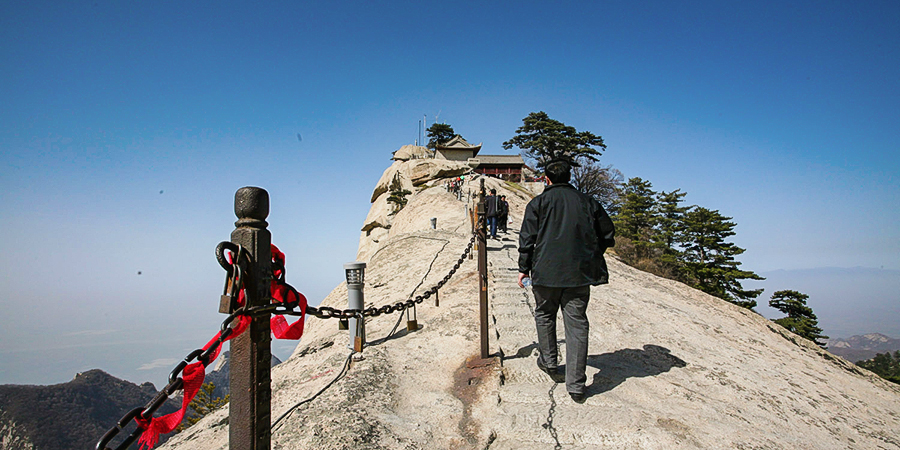Brilliance of thousand years endows Xi'an with enchanting temperament. The continuous history of the ancient civilized capital has apparently resulted in its magnificent culture. Today's Xi'an is a world famous tourist city and an inexhaustible treasure house of cultural relics. Now heads of state from many countries and people from all walks of life come to the city to broaden their knowledge of Chinese civilization.
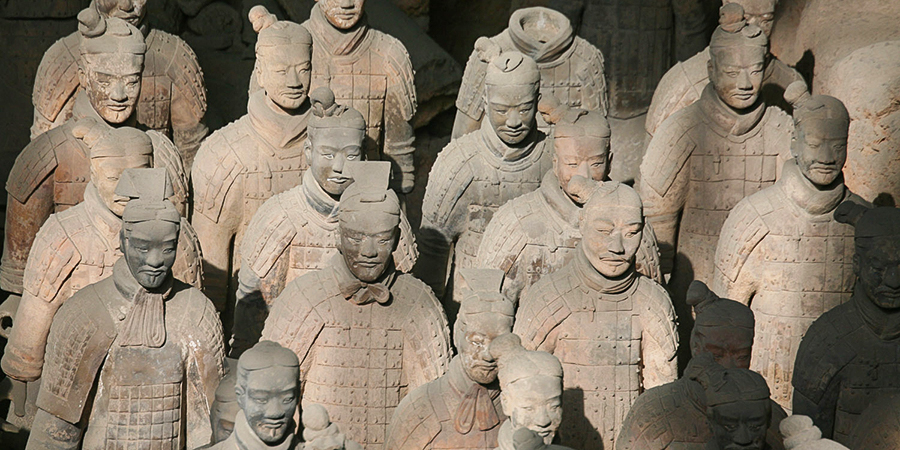
Top Attractions
 Terra Cotta Army - At the mention of the great number of the local attractions, terracotta soldiers always come as the first. The great archeological excavation of Qin (221BC-206BC) Terra Cotta Warriors and Horses unfolded a strong army of altogether 8,000 life-size pottery soldiers, horses, chariots and weapons arranged in battle formations symbolically, guarding the tomb of Emperor Qin Shi Huang. The grand Mausoleum of the first emperor of Qin and the warriors and horses buried in loess for over 2,200 years amaze every visitor there. Now the Emperor Qin Shi Huang's Mausoleum Site Park was just built on the entire tomb site to offer more spots to enrich your Xi'an vacation.
Terra Cotta Army - At the mention of the great number of the local attractions, terracotta soldiers always come as the first. The great archeological excavation of Qin (221BC-206BC) Terra Cotta Warriors and Horses unfolded a strong army of altogether 8,000 life-size pottery soldiers, horses, chariots and weapons arranged in battle formations symbolically, guarding the tomb of Emperor Qin Shi Huang. The grand Mausoleum of the first emperor of Qin and the warriors and horses buried in loess for over 2,200 years amaze every visitor there. Now the Emperor Qin Shi Huang's Mausoleum Site Park was just built on the entire tomb site to offer more spots to enrich your Xi'an vacation.
 City Wall - Adorned with a moat and the circular City Wall Park, the wall surrounds the square inner city. It is the most complete city wall to survive in the country, as well being one of the largest ancient military defensive systems in the world, built first in the early Ming Dynasty (1368-1644) and renovated in recent years.
City Wall - Adorned with a moat and the circular City Wall Park, the wall surrounds the square inner city. It is the most complete city wall to survive in the country, as well being one of the largest ancient military defensive systems in the world, built first in the early Ming Dynasty (1368-1644) and renovated in recent years.
 Giant Wild Goose Pagoda
Giant Wild Goose Pagoda
Located in the Qujiang Tourist Area to the southeast of the city center, this solemn ancient pagoda inside the Da Ci’en Temple was originally built in 652 during the reign of Emperor Gaozong of the Tang Dynasty (618-907). It holds the old Buddhist relics and classics taken from India by the hierarch Xuanzang. The pagoda and its surrounding areas nowadays become a popular resort for both the locals and the tourists.
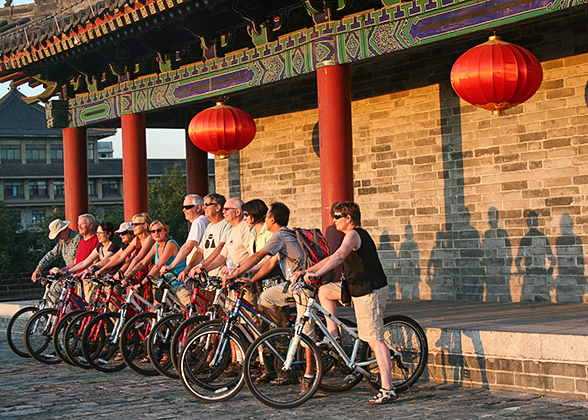 | | Cycling on Xi'an City Wall | | 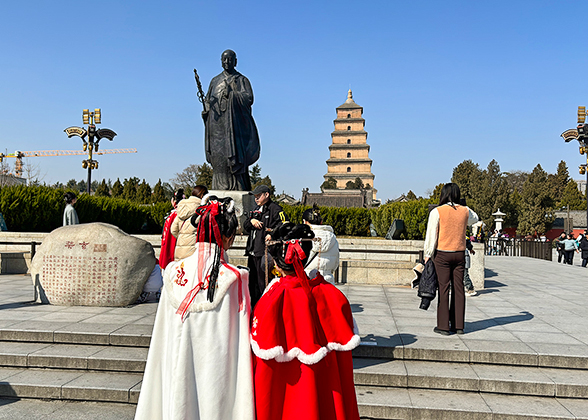 | | Giant Wild Goose Pagoda | |

See more about
Top 10 Things to Do in Xi'anMore Things to Do within City Proper
The Bell Tower plays absolutely as the central landmark of the city, from which four most prosperous commercial streets stretch towards the east, west, south and north. As another must to every Ming city, the Drum Tower stands nearby in the west of the Bell Tower. Time has passed along with the bell at dawn and the Drum at dust sounding everyday. Now, they are outstanding examples of the ancient architecture. Entering the old gate of the Drum Tower, you are warmly welcomed by an old street with bluestone pavement and full of Muslim restaurants decorated in Ming and Qing dynasties' style, Beiyuanmen Muslim Market, which is the right place to taste local snacks. The Great Mosque here occupies a narrow lot which is only a block away from the Drum Tower, being the spiritual root of about sixty thousand Muslims, mainly Hui minority living and working here. To know city wall much earlier than Ming, Hanguang Gate Site Museum provides a prefect description of the ancient wall 1,400 year ago at the zenith of Xi'an history.
Shaanxi History Museum is one of the most distinguished history museum in China, located in a quiet corner but easy of access. Within few kilometers around it, there are Big Wild Goose Pagoda in the crucial Buddhist temple, Da Cien Temple, and the biggest Tang culture theme park, Tang Paradise.
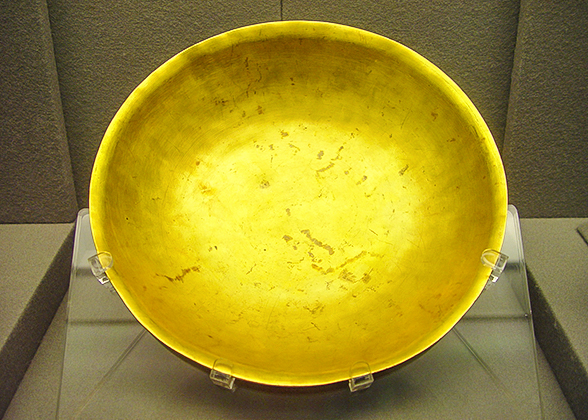 | | Gold Basin in Shaanxi History Museum | | 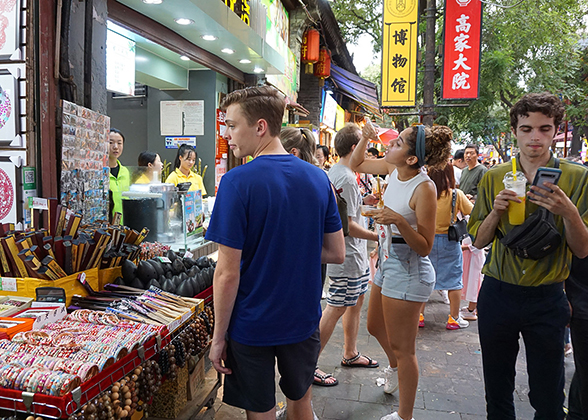 | | Muslim Quarter | |
Attractions along East Route
Driving eastward for Lintong or taking City Bus U5 (306) from the east square of the railway station, first comes the Banpo Museum which built on the ancient human village relics of Neolithic Yangshao culture. Terracotta Army is the most attractive along the east scenery line. A few minutes' drive away, there is the Huaqing Hot Springs at the north foot of Mount Li, which is favored for its scenic beauty and palace complex, becoming well-known as the spa place for Concubine Yang of Tang (618-907) Emperor Xuanzong. If leaving Lintong by train or bus, Mt. Huashan, one of the five sacred mountains in China famed for precipitous crags, narrow and steep paths, can be reached within three hours. Many visitors choose to climb the mountain at night and wait for the sun rise on the top, which extends your vacation in Xi'an to be a memorable experience.
Attractions along West Route
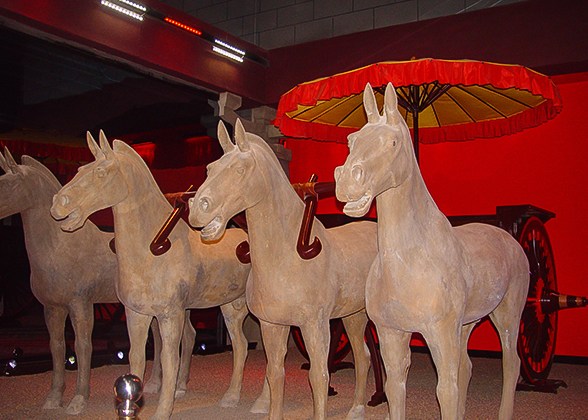 | | Exhibitions in Han Yang Ling Mausoleum | | 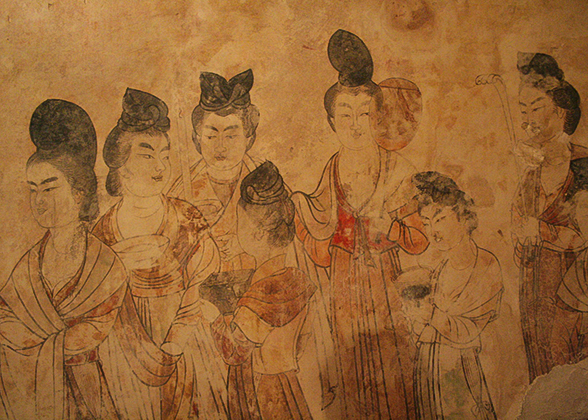 | | Murals in Zhaoling | |
About nineteen miles northwest of Xi'an, Xianyang is the first stop on the west route. It was best known as the capital of Qin Dynasty with its suburbs scattered widely with mausoleums of emperors and royal families of several dynasties: Han Yang Ling Mausoleum, the joint grave of Liu Qi, a notable emperor in Western Han (206 BC-220AD) and Empress Wang; Qianling Mausoleum, the joint tomb of Emperor Gaozong and his empress Wu Zetian, the only woman ruler in Chinese history; Zhaoling Mausoleum, the tomb of the second emperor of Tang and the first Tang imperial tomb built into the mountain. These are all grand burial complexes worth visiting. Further in Baoji, Famen Temple is a noted Buddhist shrine for its collection of Sakyamuni's relics. For picturesque mountainous scenery, Taibai Mountain is worthwhile going.
Attractions along South Route
Xingjiao Temple in Chang'an District is not well acquainted and it will be easily remembered if mentioned as the place where famous Chinese Buddhist Monk Xuanzang reposed after death. Xiangji (Heaped Fragrance) Temple is also an important Buddhist shrine. The famous Tang poetry, Wang Wei, wrote in his poem: Not knowing the way to the Temple of Xiangji, as bell come through woods without human track under miles of mountain-cloud. The words unfold a vivid picture around the temple.
Western Zhou (11th century BC-771 BC) Chariot Burial Pit is a right place to understand ancient Chinese burial system. Fenghe River area was the capital ruins of Western Zhou and the burial pits on the west bank in present Chang'an District provide fair evidences to study the burial custom at that time.
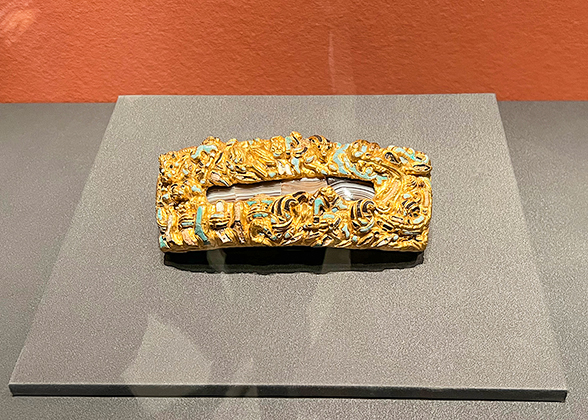 | | Gold Plague in Shaanxi Archaeology Museum | | 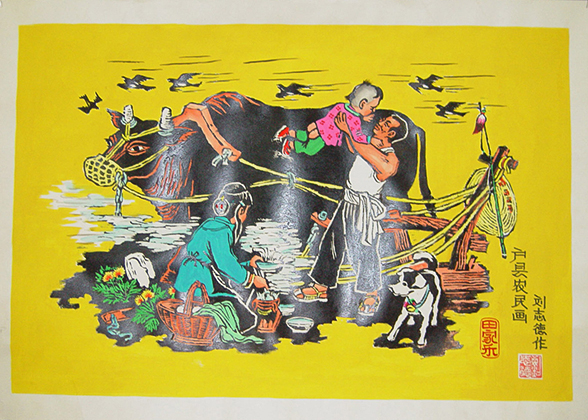 | | Peasant Painting in Huxian County | |
Attractions along North Route
Exploring further to the northeast, a small historic cultural city Hancheng, known as the hometown of famous historian and litterateur of China, Sima Qian, is the home to Sima Qian Temple, Dang Village and the Confucius Temple. Moreover, a unique type of dwelling Farmers' Caves, exists mainly in northern part of Shaanxi Province, is also worth visiting while marching northward continuously. Yan'an has the most typical and distinctive cave residences.
Others
- Last updated on Oct. 14, 2024 by Catherine He -

![]() Terra Cotta Army - At the mention of the great number of the local attractions, terracotta soldiers always come as the first. The great archeological excavation of Qin (221BC-206BC) Terra Cotta Warriors and Horses unfolded a strong army of altogether 8,000 life-size pottery soldiers, horses, chariots and weapons arranged in battle formations symbolically, guarding the tomb of Emperor Qin Shi Huang. The grand Mausoleum of the first emperor of Qin and the warriors and horses buried in loess for over 2,200 years amaze every visitor there. Now the Emperor Qin Shi Huang's Mausoleum Site Park was just built on the entire tomb site to offer more spots to enrich your Xi'an vacation.
Terra Cotta Army - At the mention of the great number of the local attractions, terracotta soldiers always come as the first. The great archeological excavation of Qin (221BC-206BC) Terra Cotta Warriors and Horses unfolded a strong army of altogether 8,000 life-size pottery soldiers, horses, chariots and weapons arranged in battle formations symbolically, guarding the tomb of Emperor Qin Shi Huang. The grand Mausoleum of the first emperor of Qin and the warriors and horses buried in loess for over 2,200 years amaze every visitor there. Now the Emperor Qin Shi Huang's Mausoleum Site Park was just built on the entire tomb site to offer more spots to enrich your Xi'an vacation.![]() City Wall - Adorned with a moat and the circular City Wall Park, the wall surrounds the square inner city. It is the most complete city wall to survive in the country, as well being one of the largest ancient military defensive systems in the world, built first in the early Ming Dynasty (1368-1644) and renovated in recent years.
City Wall - Adorned with a moat and the circular City Wall Park, the wall surrounds the square inner city. It is the most complete city wall to survive in the country, as well being one of the largest ancient military defensive systems in the world, built first in the early Ming Dynasty (1368-1644) and renovated in recent years.![]() Giant Wild Goose Pagoda
Giant Wild Goose Pagoda